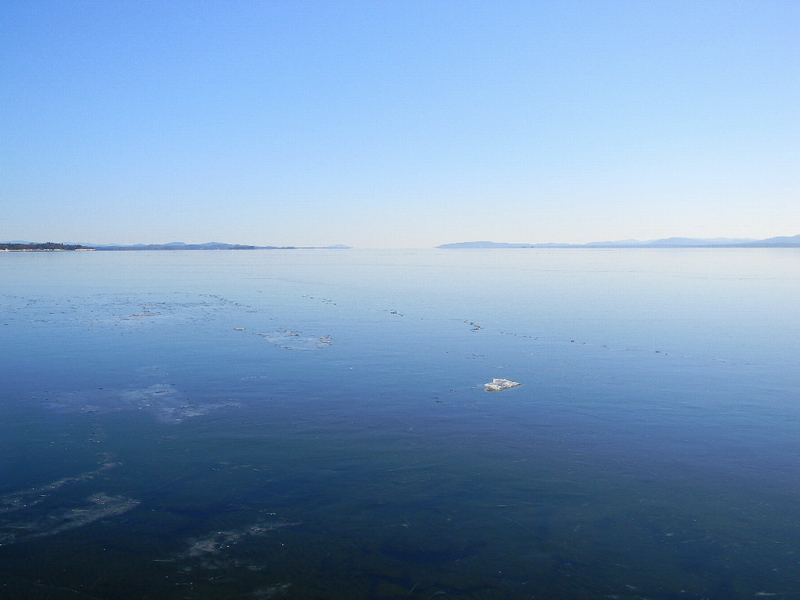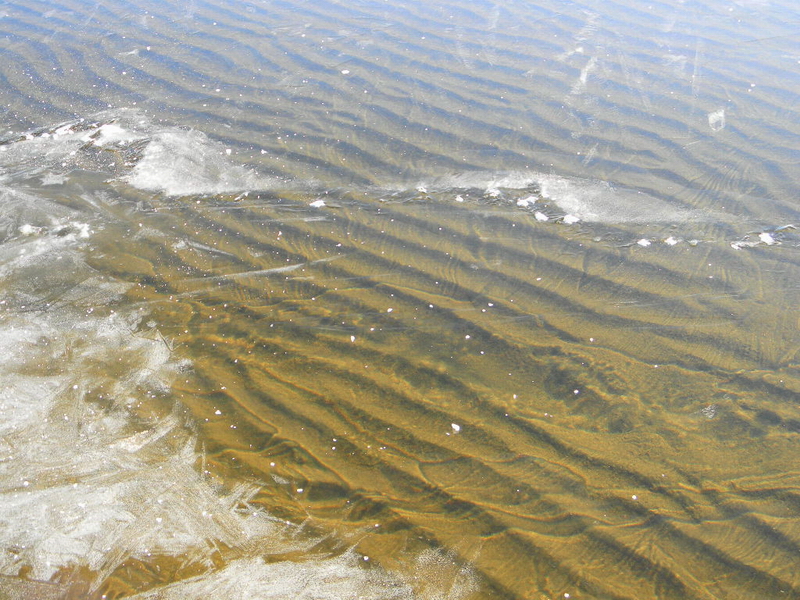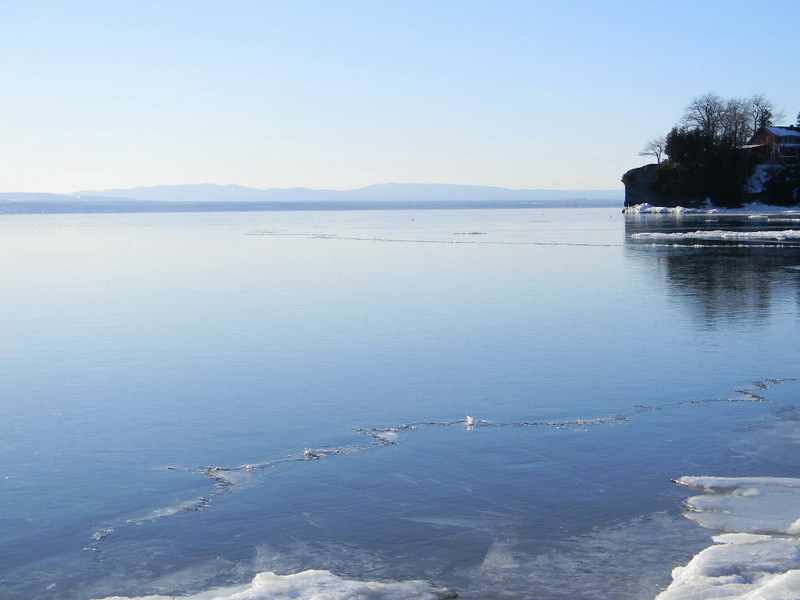Big New Ice
Late Season Ice Fever Strikes Four On Lake Champlain
Airplane view of the northern end of a one day old black ice sheet on Lake Champlain. Colchester Point near the center of the picture. Barney Point is the next point this way (see pictures below). The blue color to the west of the white shoreline ice is 2" (+/-) black ice.
Big and deep lakes (dimensions of a few miles) like Lake Champlain freeze over slowly with shallow, protected bays coming in first. The deepest and biggest section is the last to come in as it takes longer for the water to cool and the quiet, cold conditions that typically let it catch are less likely on large expanses of open water. The early morning of Tuesday Feb 22, 2011 the temperature dropped to near zero. The wind was light from late Monday the 21st through mid morning on Thursday the 24th.
 From the edge of the ice: looking south from Barney Point (Colchester Vt): 15 miles of black ice. Photo: Paul Gervais
From the edge of the ice: looking south from Barney Point (Colchester Vt): 15 miles of black ice. Photo: Paul Gervais Ripple pattern in the sand under the ice. Near Barney Point. Photo: Paul Gervais
Ripple pattern in the sand under the ice. Near Barney Point. Photo: Paul Gervais
 Barney Point Looking west. Ice does not get much smoother than this. Photo: Paul Gervais
Barney Point Looking west. Ice does not get much smoother than this. Photo: Paul Gervais
Prior to this cold still period, the center of the lake (see the blue lines below) was the only remaining open water on the lake. The deep water had finally cooled enough to be ready to catch. It froze the night of February 22. The wind was back by the morning of the 24th with gusts to 30 mph by mid day. Friday (the 25th) it snowed about 7” (0.38” water equivalent- sufficient weight to submerge the new ice sheet). On Friday night some combination of things including the weight of the snow and north winds gusting to 35+ mph took out the entire new sheet and stuffed it into one quarter of its original area (between the southern blue and red lines on the map).
Central Lake Champlain: Blue lines mark the edge of the black ice that came in the night of Feb 22. The red line marks the north edge of where that that ice was stuffed by strong north winds the night of 2/25.
I know of four people who skated on the mornings of the 24th or 25th. They were prepared for ice testing and self rescue. The wisdom of their choice to get out on ‘miles of great black ice’ before the predicted snow was going to ruin it for skating has been questioned and rationalized on a couple of sailing and skating sites. They reported ice thicknesses between less than two to up to three inches. These measurements have an uncertainty of roughly 3/4", not a problem at 3" but a big question mark at 1-1/2". The person skating on the southern end of the new sheet on the 24th reported wide leads: a sign that the ice is vulnerable to breaking up.
I have not watched a big, thin ice sheet break up however, I expect it looks great until it doesn't and then it gets treacherous very quickly.
Airplane view of the southern end of the new sheet looking south west. Essex NY at the edge of the old ice. Note the east west lead a bit north of Essex. I do not believe the Essex Ferry has sailed through ice sheet yet (1:00 PM Feb 23)
**********************************************************************
Eric Anderson (CT DN sailor) Tells of a Similar Situation in Sweden
From Eric's email:
“I sailed on Lake Vattern at a DN world championshipin 2006. What a beautiful lake. We (~ 180 DNs) originally set up south of the town of Motala at Vadstena Bay on fairly thin new black ice. The plate was around 10 miles X 15 miles. The race committee requested people not sail until they checked the ice carefully and they spend a day doing so. There was a big disagreement among the iceboaters about how safe the sailing was there with a number of Germans and Poles refusing to sail there because they felt the ice was not safe. The Swedes assured everyone that it was fine and the ice was good. By the next morning (when we were supposed to race) the whole plate was broken up and gone. The ice ended about 50 yards beyond the pit area. Scary stuff. We could potentially have had 200 plus people on the ice when it broke up.”
Vattern Lake about 120 mi SW of Stockholm
The bay just west of Motala is a little over 2 miles wide and about 7 miles from north to south. Vadsena Bay is a smaller bay on the south end of the larger bay.
Editor's note: Lake Vattern is 1.5x bigger than Lake Champlain with almost twice the average depth. Its shape makes the lake especially likely to have strong sieches (underwater waves). It has a reputation for ice sheets blowing out into the lake. The weather history from Stockholm (120 miles away) suggests the ice came in a few days before the break up. It was cold enough to grow to about four inches. It is very likely that the main body of the lake was open which makes exposed bays with new ice vulnerable to both waves, underwater currents and off-edge wind. The consensus of the people I have talked to about this think it was wind rather than currents in this case. The wind switched from on-shore to off-shore about a day before the ice sheet departed.
All this is to say that big ice does things that pond ice does not. Bigger, better prepared, more experienced groups are more likely to avoid problems and better able to handle any they encounter. There is still the potential for situations that no group will be able to deal with: for example if the sheet comes apart before they can get off. What you can see from the shore (or standing on the ice) is only a tiny piece of what is out there and it is likely that there are all sorts of problems beyond what you can see. More importantly, while it is thin, it is at high risk of being broken up if the wind comes up. Three of the four skaters mentioned in the above Lake Champlain story anticipated this risk and chose to stay close to shore and over (mostly) shallow water.
Those of us who are vulnerable to ice fever (which probably includes many of the people reading this) need to be especially careful when confronted with a huge piece of great looking black ice. It is always good to remind yourself that if this sheet gets ruined by a snow storm before it gets acceptably thick, there will be another similar, but more reasonable, ice sheet somewhere, if not this year, then certainly next.
click here for a spectacular video of a wayward sheet colliding with a landfast sheet on Lake Vattern.
Bob
PS: Click here for a report on a 'big ice break up' rescue in Sweden in early January 2011 and a couple of spectacular pictures. The wake from an icebreaker crossing the ice sheet they were on broke it into many seporated pieces. The skaters were rescued in 12 minutes (thanks to their cellphone and a nearby, helicopter equipped, rescue unit). Typical rescue times are more like 30-45 min. Click here for the story in Swedish and with better pictures.
